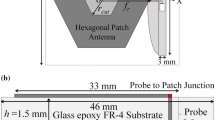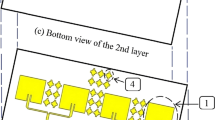Abstract
Demand of antennas those possess wide radiation bandwidth while operating in S-band for wireless communication systems is increasing day by day. Thick substrates are popular solution to achieve wideband but they lead to frequency shift and suffer from limited gain. A potential technique to overcome the issue is to integrate an artificial magnetic conductor (AMC) between dielectric layers of a probe-fed thick substrate antenna as proposed in the paper. A parallel plate capacitor is incorporated to compensate impedance mismatch due to inductive probe. An operating band of 340 MHz is observed between 2.24 and 2.58 GHz for a gain greater than 0 dB while antenna exhibits a peak gain of 6.7 dBi. The proposed low profile AMC integrated hexagonal antenna is easy and economical to fabricate using multilayer printed circuit boards. The square loop AMC is analyzed with different inner widths to estimate the band stop frequency in both TE and TM modes. The phenomenon observed in presence of AMC during design and simulations of S-band antenna are validated with experimental results.










Similar content being viewed by others
References
Bilotti, F., & Vegni, C. (2001). Rigorous and efficient full-wave analysis of trapezoidal patch antennas. IEEE Transactions on Antennas and Propagation,49(12), 1773–1776. https://doi.org/10.1109/8.982459.
Bilotti, F., Alu, A., Manzini, M., & Vegni, L. (2003). Design of polygonal patch antennas with a broad-band behavior via a proper perturbation of conventional rectangular radiators. In IEEE antennas and propagation society international symposium. Digest held in conjunction with: USNC/CNC/URSI North American Radio Science Meeting (Cat. No.03CH37450), Vol. 2, pp. 268–271. https://doi.org/10.1109/aps.2003.1219229.
Bilotti, F., & Vegni, C. (2010). Design of polygonal patch antennas for portable devices. Progress in Electromagnetics Research B,24, 33–47. https://doi.org/10.2528/pierb10020208.
Nascimento, D. C., & Lacav, J. C. D. S. (2011). Design of low-cost probe-fed microstrip antennas. microstrip antennas. https://www.intechopen.com/books/microstrip-antennas/design-of-low-cost-probe-fed-microstrip-antennas.
Ray, K. P., Pandey, M., Rashmi, R., & Duttagupta, S. P. (2013). Compact configurations of hexagonal microstrip antennas. Microwave and Optical Technology Letters,55, 604–608. https://doi.org/10.1002/mop.27396.
Joshi, A., & Singhal, R. (2016). Performance comparison of probe-fed polygonal patch antennas for L-band applications. In 2016 IEEE Region 10 Conference (TENCON), Singapore. Nov. 22–25, pp. 1307–1311. https://doi.org/10.1109/tencon.2016.7848224.
Qian, K., & Tang, X. (2011). Compact LTCC dual-band circularly polarized perturbed hexagonal microstrip antenna. IEEE Antennas and Wireless Propagation Letters,10, 1212–1215. https://doi.org/10.1109/lawp.2011.2173654.
Celozzi, S., Araneo, R., & Lovat, G. (2008). Electromagnetic shielding. Wiley-Interscience, Hoboken, NJ. https://doi.org/10.1002/9780470268483.ch10.
Munk, B. A. (2000). Frequency selective surfaces: Theory and design. Wiley, New York. ISBN: 0-471-37047-9.
Mittra, R., Chan, C., & Cwik, T. (1988). Techniques for analyzing frequency selective surfaces-a review. Proceedings of the IEEE,76(12), 1593–1615. https://doi.org/10.1109/5.16352.
Ma, D., & Zhang, W. X. (2007). Mechanically tunable frequency selective surface with square-loop-slot elements. Journal of Electromagnetic Waves and Applications,21(15), 2267–2276. https://doi.org/10.1163/156939307783134407.
Lu, B., Gong, S. X., Ling, J., & Wang, X. (2009). The design and performance of a novel square-loop patch frequency selective surface. Journal of Electromagnetic Waves and Applications,23, 1085–1092. https://doi.org/10.1163/156939309789023510.
Liu, N., Sheng, X., Zhang, C., Fan, J., & Guo, D. (2017). A design method for synthesizing wideband band-stop FSS via its equivalent circuit model. IEEE Antennas and Wireless Propagation Letters,16, 2721–2725. https://doi.org/10.1109/LAWP.2017.2743114.
Barrera, M. A. R., & Carpes, W. P. (2017). Bandwidth for the equivalent circuit model in square-loop frequency selective surfaces. IEEE Transactions on Antennas and Propagation,65(11), 5932–5939. https://doi.org/10.1109/TAP.2017.2754418.
Nasrollahi, H., Yeganeh, A. N., Sedighy, S. H., & Mohammad-Ali-Nezhad, S. (2017). Compact, dual polarized, mutliband frequency selective surface with wideband spurious rejection. Microwave and Optical Technology Letters,59, 888–893. https://doi.org/10.1002/mop.30420.
Liu, T., & Kim, S.-S. (2018). Design of ultra wide-bandwidth double-layer electromagnetic wave absorbers with square-loop frequency selective surfaces. Microwave and Optical Technology Letters,60, 2013–2018. https://doi.org/10.1002/mop.31287.
Gombor, T., & Pavo, J. (2015). Numerically efficient modeling of frequency selective surfaces in broad frequency range. IEEE Transactions on Magnetics,51, 1–4. https://doi.org/10.1109/TMAG.2014.2362874.
Varkani, A. R., Firouzeh, Z. H., & Nezhad, A. Z. (2018). Design of a randomised arrangement AMC surfaces for RCS reduction based on equivalent circuit modelling. IET Microwaves, Antennas & Propagation,12(10), 1684–1690. https://doi.org/10.1049/iet-map.2017.1146.
Ferreira, D., Caldeirinha, R. F. S., Cuinas, I., & Fernandes, T. R. (2015). Square loop and slot frequency selective surfaces study for equivalent circuit model optimization. IEEE Transactions on Antennas and Propagation,63(9), 3947–3955. https://doi.org/10.1109/TAP.2015.2444420.
Kartal, M., Golezani, J. J., & Doken, B. (2017). A triple band frequency selective surface design for GSM systems by utilizing a novel synthetic resonator. IEEE Transactions on Antennas and Propagation,65(5), 2724–2727. https://doi.org/10.1109/TAP.2017.2670230.
Joshi, A., & Singhal, R. (2016). Probe-fed regular hexagonal narrow-slot antenna with reduced ground plane for WLAN applications. In 2016 IEEE region 10 conference (TENCON), Singapore. November 22–25, pp. 1312–1316. https://doi.org/10.1109/tencon.2016.7848225.
Sawant, K.K., & Kumar, C.S. (2015). CPW fed hexagonal micro strip fractal antenna for UWB wireless communications. AEU—International Journal of Electronics and Communications, 69(1), 31–38. https://doi.org/10.1016/j.aeue.2014.07.022.
Ghatak, R., Karmakar, A., & Poddar, D. (2013). Hexagonal boundary Sierpinski carpet fractal shaped compact ultrawideband antenna with band rejection functionality. AEU—International Journal of Electronics and Communications, 67(3), 250–255. https://doi.org/10.1016/j.aeue.2012.08.007.
Liu, J., Tang, Z., & Yin, Y. (2017). Wideband omni-directional antenna with novel feeding structure for improving radiation patterns. Electronics Letters,53(13), 830–832. https://doi.org/10.1049/el.2017.0941.
Kovitz, J. M., & Rahmat-Samii, Y. (2014). Using thick substrates and capacitive probe compensation to enhance the bandwidth of traditional CP patch antennas. IEEE Transactions on Antennas and Propagation,62(10), 4970–4979. https://doi.org/10.1109/tap.2014.2343239.
Kasabegoudar, V. G., & Vinoy, K. J. (2010). Coplanar capacitively coupled probe fed microstrip antennas for wideband applications. IEEE Transactions on Antennas and Propagation,58(10), 3131–3138. https://doi.org/10.1109/tap.2010.2055781.
Bashiri, M., Ghobadi, C., Nourinia, J., & Majidzadeh, M. (2017). WiMAX, WLAN, and X-band filtering mechanism: Simple-structured triple-band frequency selective surface. IEEE Antennas and Wireless Propagation Letters,16, 3245–3248. https://doi.org/10.1109/LAWP.2017.2771265.
Rajagopal, S., Chennakesavan, G., Subburaj, D.R.P., Srinivasan, R., Varadhan, A.: A dual polarized antenna on a novel broadband multilayer artificial magnetic conductor backed surface for LTE/CDMA/GSM base station applications. AEU—International Journal of Electronics and Communications, 80, 73–79 (2017). 10.1016/j.aeue.2017.06.028.
Yang, W., Che, W., & Wang, H. (2013). High-gain design of a patch antenna using stub-loaded artificial magnetic conductor. IEEE Antennas and Wireless Propagation Letters,12, 1172–1175. https://doi.org/10.1109/lawp.2013.2280576.
Alibakhshi-Kenari, M., Naser-Moghadasi, M., Sadeghzadeh, R. A., Virdee, B. S., & Limiti, E. (2016). Periodic array of complementary artificial magnetic conductor metamaterials-based multiband antennas for broadband wireless transceivers. IET Microwaves, Antennas & Propagation,10(15), 1682–1691. https://doi.org/10.1049/iet-map.2016.0069.
Tahir, F. A., Arshad, T., Ullah, S., & Flint, J. A. (2017). A novel FSS for gain enhancement of printed antennas in UWB frequency spectrum. Microwave and Optical Technology Letters,59, 2698–2704. https://doi.org/10.1002/mop.30789.
Tahir, F. A. (2016). A novel single-layer frequency selective surface for gain enhancement of SWB antennas. Microwave and Optical Technology Letters,58, 2030–2035. https://doi.org/10.1002/mop.29966.
Krishna, R. R., & Kumar, R. (2015). Slotted ground microstrip antenna with FSS reflector for high-gain horizontal polarisation. Electronics Letters,51(8), 599–600. https://doi.org/10.1049/el.2015.0339.
RamKrishna, R. V. S., Kumar, R., & Kushwaha, N. (2014). A circularly polarized slot antenna for high gain applications. AEU—International Journal of Electronics and Communications, 68(11), 1119–1128. https://doi.org/10.1016/j.aeue.2014.05.018.
Dewan, R., Rahim, M., Hamid, M., Yusoff, M., Samsuri, N., Murad, N., et al. (2017). Artificial magnetic conductor for various antenna applications: An overview. International Journal of RF and Microwave Computer-Aided Engineering,27(6), 1–18. https://doi.org/10.1002/mmce.21105.
Hosseinipanah, M., & Wu, Q. (2010). Characteristic estimation of artificial magnetic conductors. Electromagnetics,30(5), 435–447. https://doi.org/10.1080/02726343.2010.483934.
Nasimuddin, N., Chen, Z. N., & Qing, X. (2016). Bandwidth enhancement of a single-feed circularly polarized antenna using a metasurface: metamaterial-based wideband CP rectangular microstrip antenna. IEEE Antennas and Propagation Magazine,58(2), 39–46. https://doi.org/10.1109/MAP.2016.2520257.
Joshi, A., & Singhal, R. (2019). Characteristics analysis of a square loop-based artificial magnetic conductor. 2019 IEEE Indian conference on antennas and propogation (InCAP) (pp. 1–4). India: Ahmedabad.
Lee, C., & Langley, R. (1985). Equivalent-circuit models for frequency-selective surfaces at oblique angles of incidence. IEE Proceedings H Microwaves, Antennas and Propagation,132(6), 395–399. https://doi.org/10.1049/ip-h-2.1985.0070.
Langley, R., & Parker, E. (1982). Equivalent circuit model for arrays of square loops. Electronics Letters,18(7), 294–296. https://doi.org/10.1049/el:19820201.
Joshi, A., & Singhal, R. (2020). Gain enhancement in probe-fed hexagonal ultra wideband antenna using AMC reflector. Journal of Electromagnetic Waves and Applications, 33(9), 1185–1196. https://doi.org/10.1080/09205071.2019.1605939.
Dubrovka, R., Vazquez, J., Parini, C., & Moore, D. (2006). Equivalent circuit method for analysis and synthesis of frequency selective surfaces. IEE Proceedings—Microwaves, Antennas and Propagation, 153(3), 213–220. https://doi.org/10.1049/ip-map:20050198.
Joshi, A., & Singhal, R. (2018). Lower mode excitation in vertex-fed slotted hexagonal S-band antenna. AEU—International Journal of Electronics and Communications, 87, 180–185. https://doi.org/10.1016/j.aeue.2018.02.008.
Zhang, X., & Zhu, L. (2016). High-gain circularly polarized microstrip patch antenna with loading of shorting pins. IEEE Transactions on Antennas and Propagation,64(6), 2172–2178. https://doi.org/10.1109/TAP.2016.2552544.
Mandal, K., & Sarkar, P.P. (2013). A compact high gain microstrip antenna for wireless applications. AEU—International Journal of Electronics and Communications, 67(12), 1010–1014. https://doi.org/10.1016/j.aeue.2013.06.001.
Acknowledgements
This research work was funded in part by Department of Science and Technology, India, New Delhi (Ref. No.: SR/FST/ETI-346/2013).
Author information
Authors and Affiliations
Corresponding author
Additional information
Publisher's Note
Springer Nature remains neutral with regard to jurisdictional claims in published maps and institutional affiliations.
Rights and permissions
About this article
Cite this article
Joshi, A., Singhal, R. Probe-fed wideband AMC-integrated hexagonal antenna with uniform gain characteristics for WLAN applications. Wireless Netw 26, 3569–3578 (2020). https://doi.org/10.1007/s11276-020-02282-7
Published:
Issue Date:
DOI: https://doi.org/10.1007/s11276-020-02282-7




